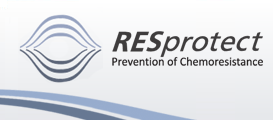| Combating Chemoresistance |

|

|

|
Page 3 of 4
Inhibitors for receptors of the tyrosine kinase pathway, such as ERBB2 and inhibitors of the expression of single oncogenes like STAT3, are evolving too but have similar limitations. Antiapoptotic survival pathways involve oncogenes like STAT3 and JUN-D (2) Constitutively activated STAT3 is oncogenic and contributes to the development of various human cancers by inhibiting apoptosis. Thus, STAT3 promotes cell survival and renders cancer cells resistant to chemotherapy. Accordingly, the inhibition of STAT3 signalling induces apoptosis specifically in tumour cells, and increases sensitivity to chemotherapeutic agents. Hence, the management of chemoresistance, at its best, has to address all of the options a cell is capable of to render therapy ineffective. Several issues need to be addressed in order to develop drugs that inhibit or prevent induction of chemoresistance. The effectivity of drugs on the molecular level is one matter; their effectiveness in vitro and in vivo another. In the long run, in vitro treatment of tumour cells with cytotoxic drugs leads to the induction of resistance and the increase of cells. Co-treatment with a chemoresistance inhibitor maintains the chemosensitivity of cells. Drugs that are not effective with respect to maintenance of chemosensitivity are excluded from further studies. On the next level, the candidates are tested in in vivo tumour models. Naked mouse experiments are not advisable because the prediction of effectiveness is not better than that of in vitro experiments. Candidates who pass this barrier are tested for their toxicological profile. Cytotoxic substances are most probably detected before the in vitro and in vivo experiments and have been already excluded. Only promising candidates reach the toxicology level. The most promising candidate is tested in clinical trials. To my knowledge, none of the drugs that are in the developmental pipelines of pharmaceutical and biotech companies throughout the world are intended to inhibit or prevent induction of chemoresistance. Drugs which circumvent or attack already existing chemoresistance address only gp-120 (MDR-1) with varying specificity, but gp-120 is only one of several reasons for chemoresistance. Inhibitors of receptors for the tyrosine kinase pathway such as ERBB2 (Herceptin) and inhibitors of the expression of single oncogens or STAT3 are in development too. However, the use of such drugs is restricted to tumours with a specific genetic profile. Chemoresistance is a multifactorial event, but since the development of inhibitors of chemoresistance is focused only on one target mechanism, no valuable drugs exist so far. There are several substances that are active on one or two levels. Besides the compounds mentioned previously, base analogs like (E)-5-(2-bromovinyl)-2’-deoxyuridine (BVDU, RP101); 5-iodo-2’-deoxyuridine (IDU), 5-iodo-2’-deoxycytidine (IDC); 2´-deoxy-5-trifluoromethyl-uridine (DTFMU), are active as antirecombinogens. However, since many base analogs are cytostatic, they do not reach the higher levels of testing. The first drug showing the desired profile is BVDU (RP101). In a clinical pilot study with 13 pancreas cancer patients, survival and time to progression was roughly doubled. The same tendency was seen in a follow-up study that started in December 2004.
|
||||||


